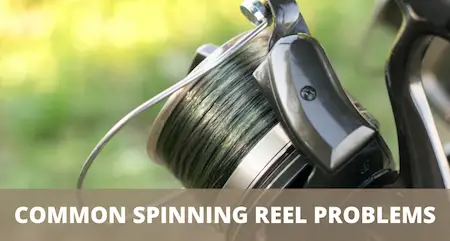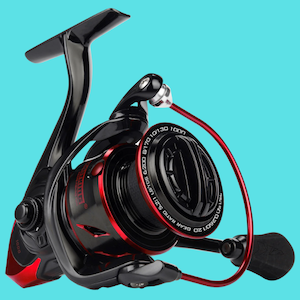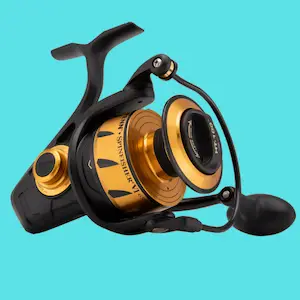Common Spinning Reel Problems (And How To Fix Them)
UPDATED 03 NOVEMBER 2023
by Robert Ceran
If you’re an angler, chances are that at some point or another, you’ve had to deal with spinning reel problems.
Whether it’s that the fishing line won’t reel in properly, the bail won’t close, or you get birds nest formation, there are many issues that can happen with a spinning reel.
While the best thing is to avoid these problems in the first place with proper use and maintenance, if you do run into a problem, you need to know how to deal with it.

In this article we’ll explain how to fix the most common spinning reel problems, and offer advice on what could be causing them.
1. Spinning reel not reeling in
This is most often caused by one of these 3 problems:
- Braid slipping on spinning reel spool
- Spinning reel locked up
- Line not under bail arm
Let’s look at each of these issues in more detail, and discuss how to fix fishing reel that won’t reel in.
Braided line slipping on spool
If you tie braided line directly to the spool of a spinning reel that’s not braid-readyl, this often results in line slipping, since the braid doesn’t stick on the smooth aluminum or graphite surface of the spool.
When this happens, you’ll see the bail arm turning around the spool while you rotate the handle, but the fishing reel won’t reel in line, due to line slippage on the spool surface.
How to fix it: there are two ways to stop braid slipping on the spool. The easiest is to put electrical tape on the spool surface before tying braid to it. Electrical tape essentially makes your spool braid-ready, since braided line doesn’t slip on it.
The second way to do this is by spooling a monofilament backing, and then tying your braided mainline to that (which we cover in more detail in our article on using braid with a spinning reel).
Spinning reel locked up
If your spinning reel gets stuck, and you find that you can’t turn the handle, that usually means it’s jammed.
This happens most often to saltwater spinning reels without sealing technology, especially if they’ve been exposed to lots of salt spray (or even dunked in salt water).
The saltwater can cause the reel to seize up due to salt deposits forming on the gears, ball bearings, and other internal parts. Another cause of this can be sand or dirt getting inside the body.
How to fix it: in order to fix a jammed spinning reel, you’ll need to take it apart completely, clean the internal parts, degrease the gears, and then add new grease and oil to the appropriate spinning reel parts.
If you’re a beginner, it’s usually better not to try this yourself, as it can be hard to put it back together again, and you also need to make sure to use only the right oil and grease.
So instead of attempting to fix a stuck spinning reel yourself, it’s better to send it to a professional cleaning service, who will probably do a much better job.
Line not running under bail arm
If you’re new to fishing, there’s a chance that you forgot to run the line underneath the bail arm when you set up your rod and reel. In that case no line will be wrapped around the spool when you turn the handle, even though the bail arm is rotating around the spool.
How to fix it: fortunately, this issue is very easy to fix. Unscrew the drag knob at the top of the spool, and remove the spool from the spinning reel.
Then open the bail arm, and put the spool back in place. Now when you close the bail arm, the line will run under it, and you’ll be able to retrieve the line by turning the handle.
2. Spinning reel hard to turn
If your spinning reel feels stiff, and the handle is hard to turn, this is most often caused by salt or sand getting inside the body, and forming deposits on the gears and other internal parts.
However, in some cases, this problem can also be due to too much grease on the gears, or the wrong grease or oil having been used on the internal parts.
How to fix it: in order to fix a stiff fishing reel, you need to take it apart, and then clean and degrease the internal parts, followed by adding new grease and oil to the appropriate parts.
It’s important to use only oil and grease that are specifically designed for this purpose, as using the wrong ones can slow down your reel, due to the wrong viscosity.
For more details check our article on how to maintain a spinning reel. In addition, taking apart it and putting it back together again can be challenging if you’ve never done it before, which is why we recommend asking a professional service to do it for you instead.
The great thing is that if done correctly, this will make your spinning reel smoother, and make it feel like you’ve upgraded it when you use it again.
3. Spinning reel won’t lock
If your spinning reel keeps going backwards, this is usually due to the fact that the anti reverse mechanism isn’t working properly, which can be caused by to two issues:
- Anti reverse switch is set to ‘off’
- Anti reverse is broken
If you’re a novice angler, there’s a chance you overlooked the anti-reverse switch on your spinning reel.
It’s usually located at the bottom (or the back) of the reel, and has two settings: ‘on’ or ‘off.’ When the anti reverse switch is set to ‘off,’ this allows your reel to turn freely in both directions (some anglers use this to release line from their spool).
However, if you want to stop the handle from spinning backwards, make sure the anti reverse switch is set to ‘on.’
If the handle can turn backwards even when the anti reverse is turned to ‘on,’ that means the anti reverse mechanism is broken. There are two issues that usually cause this, and fortunately, both of them can be fixed.
How to fix it: a defective anti reverse is often due to a spring that normally attaches the anti reverse gear to the rotor being broken, or not properly connected. If the latter is the case, the spring can usually be reconnected quite easily.
The second common reason for a defective anti reverse is due to the hammer of the anti reverse getting caught on the latching gear.
In order to fix this, the bushing inside the gear needs to be taken out and then reinserted with a suitable adhesive, to stop it from moving inside the gear.
If you’ve never done this before, it’s usually best to get a professional reel repair service to do it for you.
4. Spinning reel line keeps getting tangled
If your spinning reel keeps getting tangled, or throwing off wind knots, this is usually due to line twist, which can be caused either by incorrect spooling, or by using lures or rigs that twist the line while fishing.
How to fix it: the first step to prevent line twist on a spinning reel is to spool it correctly. In order to do this, make sure that the line comes off the line spool in the same direction as the bail arm rotates around the spool (for more details check our guide on spooling a spinning reel).
If you do this incorrectly, it automatically introduces line twist during the spooling process, so you need to pay close attention to getting it right.
The second step to avoiding line twist is to use a barrel swivel between your main line and your terminal tackle or lure. If you use a snap swivel, this also makes it easier to switch out rigs or lures.
Finally, if you already have a lot of line twist on your reel, you can get rid of it by releasing the line from your reel and dragging it behind your boat (without any weight or lure attached to it).
Release as much line as you can, pull it behind your boat for a while, and then retrieve it. This releases most of the line twist, and smoothes out the line.
Fortunately, backlash and birds nesting isn’t as much of a problem in spinning reels compared to baitcasters.
5. Spinning reel bail won’t close
If your spinning reel bail won’t close automatically after you start turning the handle, this is most often due to the wire of the bail arm being bent out of shape.
How to fix it: while many anglers opt for replacing the bail arm completely when it becomes bent, it’s usually possible to bend it back into its correct shape.
In order to do this, release the bail arm by unscrewing it, and then use a wrench to gently bend it back into shape.
6. Spinning reel bail arm won’t stay open
If your bail arm won’t lock in the open position when you want to make a cast with it, this is usually due to a problem with the bail spring.
How to fix it: remove the bail arm completely from the rotor, and look for the bail spring. If it’s broken you’ll need to replace it with a new one, but sometimes it just gets disconnected from the bail arm, and you can fix this by simply reinserting both ends back into their correct positions (for more details, check this video).
7. Noisy spinning reel
If your spinning reel makes noise when reeling in, this is most often caused by the roller bearing.
You can check this by rotating the handle without any line tension on the bail, and if the spinning reel doesn’t make a grinding sound, then the culprit is indeed the roller bearing.
When you open up the attachment of the bail arm to the rotor, you’ll probably notice corrosion on the roller bearing, which is the reason for the noise.
How to fix it: you have to replace the roller bearing with a new one, since oiling it unfortunately doesn’t seem to help much with this kind of issue.
Luckily though, this is easy to do, and spare parts come relatively cheap in most tackle stores (try to get one from the same brand to make sure the size fits with the size of your spinning reel).
Final remarks
This concludes our article on the most common spinning reel problems and how to fix them.
It’s good to keep in mind that most reputable spinning manufacturers offer in-house repair services, and all you need to do is send your reel to them for a small fee. Usually, you’ll get it back again in mint condition within a week or two.
So unless you actually enjoy taking it apart yourself, this is often the best option to get it fixed (unless you’re dealing with a simple issue that you can take care of quickly yourself).
You may also want to consider getting a spinning reel made in USA, to ensure you’re getting the highest quality possible.



